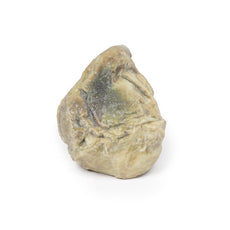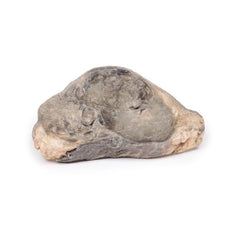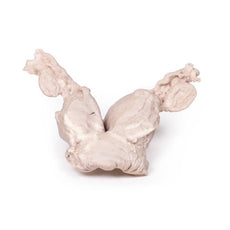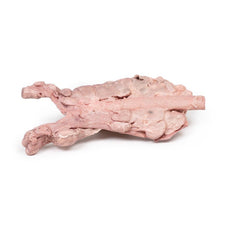Your shopping cart is empty.
3D Printed Hydronephrosis Hydroureter Caused by Obstruction by a Renal Calculus
Item # MP2094Need an estimate?
Click Add To Quote

-
by
A trusted GT partner -
FREE Shipping
U.S. Contiguous States Only -
3D Printed Model
from a real specimen -
Gov't pricing
Available upon request
3D Printed Hydronephrosis Hydroureter Caused by Obstruction by a Renal Calculus
Clinical History
A 72-year old female presented with colicky flank pain and increasing malaise.
Intermittent haematuria was noted. Biochemical investigations reveal significantly impaired renal function. CT
abdomen showed congenital renal agenesis of the left kidney and a right-sided hydronephrosis and hydroureter, due to
obstruction by a smaller calculus. Percutaneous lithotomy was attempted to relieve the obstruction, but the patient
died of a cardiac event during the procedure.
Pathology
The specimen is patient‘s right kidney, which is grossly and partially bisected. There
is gross dilatation of the pelvi-calyceal system visible and significant atrophy of renal tissue particularly in the
cortex. There is a large brown calculus visible in the renal pelvis at the ureteropelvic junction.
Further Information
Urolithiasis (renal calculi) is a very common disease affecting up to 1 in 10
individuals during their lifetime. Formation of the stones can occur anywhere along the urinary tract but most
commonly occurs within the kidneys. Risk factors for stone formation include male gender; any condition that affects
the composition of the urine, such as hypercalciuria or high urine oxalate; systemic metabolic disorders, such as
cystinuria and gout; dietary factors, such as high oxalate and animal protein intake, low fluid intake; and
environmental factors, such as high dry temperatures. 80% of renal calculi are unilateral.
Symptoms of
urolithiasis include excruciating pain, haematuria, nausea, vomiting, fainting, dysuria and urgency. Symptoms depend
on the size and the site of the calculus. Urolithiasis can be asymptomatic especially if the stones are formed and
remain within the renal pelvis or bladder. Symptoms occur when the stones move into the ureter. Pain from calculi is
usually colicky and typically severe in nature; occurring in paroxysms. The flank is the most common site for pain
but pain can occur anywhere along the urinary tract and into the genitals. Pain resolves on passage of the stone.
Haematuria can be gross or microscopic.
Diagnosis can be made based on the medical history and examination. Radiological tools frequently used to assist diagnosis include non-contrast CT or ultrasound of the kidneys and bladder. Less commonly used imaging methods include abdominal X-ray, intravenous pyelogram and magnetic resonance imaging.
If left untreated renal damage and ultimately renal failure from progressive obstruction and hydronephrosis will occur. If the obstructing calculus is not relieved it will cause pressure to build up proximal to the obstruction. This pressure is transmitted back through the collecting ducts to the cortex causing progressive atrophy of the renal parenchyma with dilatation of the renal calyces and pelvis. The pressure also compresses vasculature in the medulla leading to ischaemic medullary damage. Glomerular filtration persists in the affected kidney until late in the disease process when it will gradually diminish. Obstruction triggers an interstitial inflammatory process leading to fibrosis. Renal calculi also predispose patients to infection secondary to obstruction and the trauma that they cause to the urothelium.
Treatment in acute patients include supportive treatment to allow the passage of the stone. Medical treatment used
includes analgesia, commonly NSAIDs and opiates, and agents to aid passage of the stone, such as alpha blockers,
calcium channel blockers and antispasmodics. Surgical intervention may
be required if there are severe
complications due to calculi or if the stone is large and unable to be expelled with conservative treatment.
Surgical interventions include lithotripsy (using lasers or electricity), laparoscopic stone removal or percutaneous
stone removal. Open surgery is rarely required.
 Handling Guidelines for 3D Printed Models
Handling Guidelines for 3D Printed Models
GTSimulators by Global Technologies
Erler Zimmer Authorized Dealer
The models are very detailed and delicate. With normal production machines you cannot realize such details like shown in these models.
The printer used is a color-plastic printer. This is the most suitable printer for these models.
The plastic material is already the best and most suitable material for these prints. (The other option would be a kind of gypsum, but this is way more fragile. You even cannot get them out of the printer without breaking them).The huge advantage of the prints is that they are very realistic as the data is coming from real human specimen. Nothing is shaped or stylized.
The users have to handle these prints with utmost care. They are not made for touching or bending any thin nerves, arteries, vessels etc. The 3D printed models should sit on a table and just rotated at the table.





































































